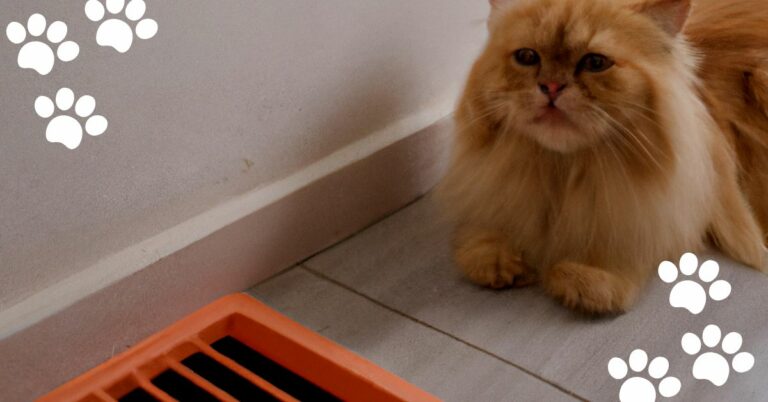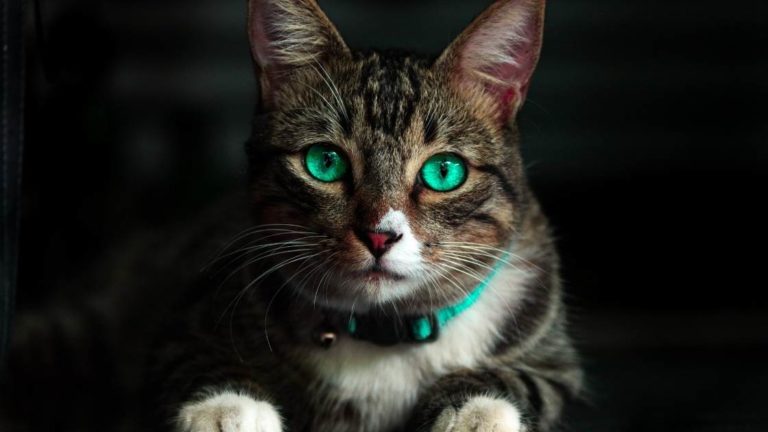How Much Miralax for a 17 Pound Cat? (Precautions)
Though it’s not commonly prescribed for cats, Miralax is a laxative that can be used to treat constipation in felines. According to VCA Hospitals, Miralax is generally considered safe for use in cats, and it can be administered either orally or by mixing it with your cat’s food.
Here I’ll share some important things to know about Miralax for cats, including dosage recommendations and possible side effects.
What is Miralax and What are its Uses?
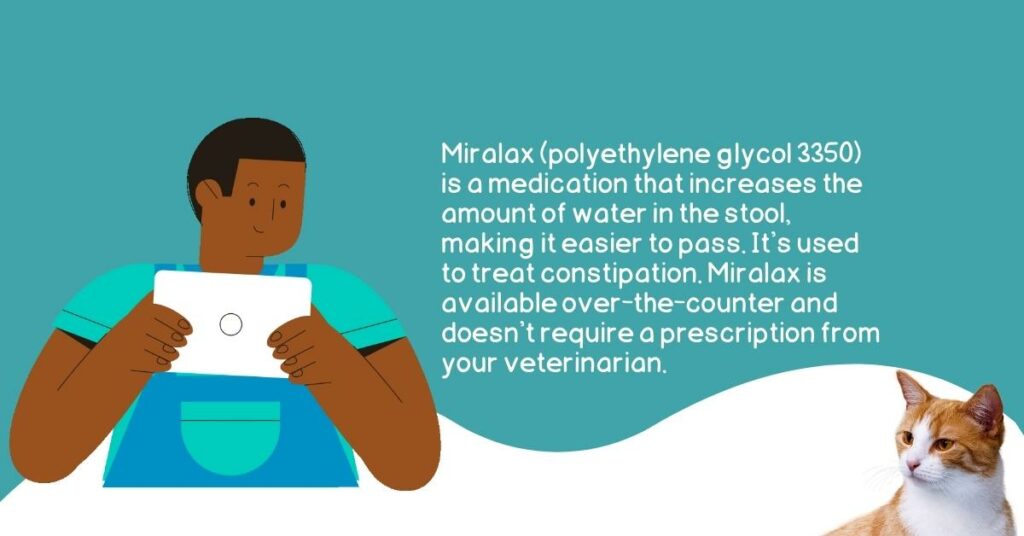
Miralax (polyethylene glycol 3350) is a stool softener that works by adding more water to your cat’s stools, making them easier to pass. It’s often used as a go-to treatment for feline constipation and as part of a therapeutic plan to resolve megacolon (a potentially life-threatening enlargement of the colon).
Many people also find that Miralax can help with hairballs because it makes it easier for cats to pass Hairballs are common in cats and are usually nothing to worry about.
However, if your cat seems to be having difficulty passing hairballs, Miralax may help. As always, talk to your veterinarian before starting any new medication. They will help you determine whether Miralax is right for your cat and advise you on the correct dosage.
Miralax Dosage for a 17 Pound Cat
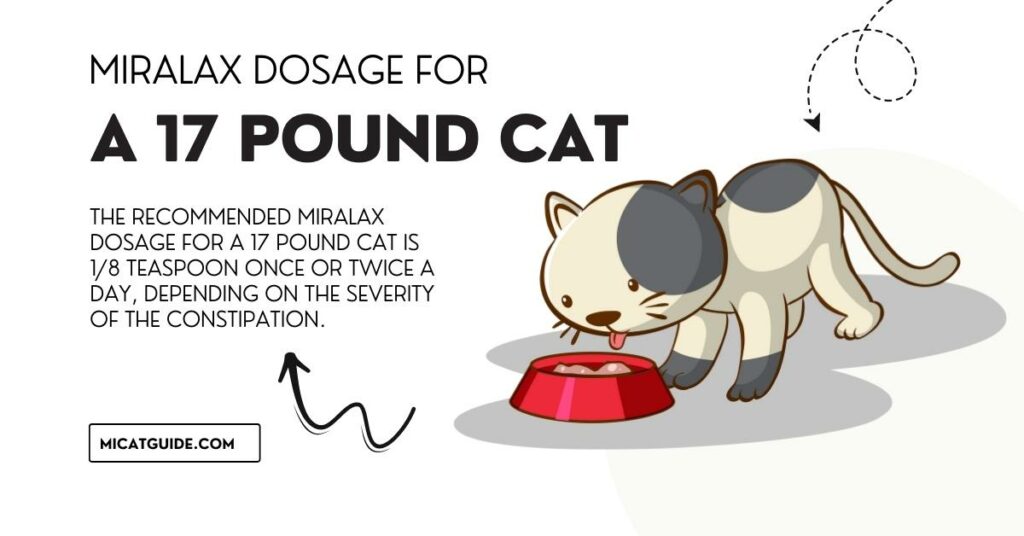
The recommended Miralax dosage for a 17 pound cat is 1/8 teaspoon once or twice a day, depending on the severity of the constipation.
Cats that are constipated typically have fewer than three bowel movements a week and may strain to defecate or produce hard, dry stools.
If your cat is eating and drinking normally and producing some stool, but not as much as usual, the 1/8 teaspoon once a day dose is likely all that will be needed.
However, if your cat hasn’t had a bowel movement in three days or more, is showing signs of discomfort (e.g., crying when attempting to defecate), or is producing only small amounts of hard stool, the 1/8 teaspoon twice a day dose may be necessary.
Is Miralax Safe for Cats?

The short answer is maybe. The longer answer is that we don’t have a lot of data to go on. This is partly because few studies have been done and partly because the studies that have been done used different protocols.
In general, the safety of any medication depends on the route of administration, the dosage, and the individual animal. For instance, Miralax is safe for people to take orally but can cause serious problems if injected.
With that said, I have seen Miralax used successfully in cats at the doses recommended on the package when administered orally. I have not heard of any reports of adverse reactions in cats at those doses, but that doesn’t mean they don’t exist.
If you decide to give your cat Miralax, do so under the guidance of your veterinarian and be sure to monitor your cat closely for any signs of adverse reactions.
How and When to Give Your Cat Miralax?
Miralax powder can be added to your cat’s wet food or mixed with a small amount of water and syringed into their mouth.
If you’re using the powder, it’s best to mix it with wet food as some cats may not take to the taste. If you’re mixing Miralax with water, give it to your cat immediately as the mixture will not hold together for long.
Precautions to Take Before Giving Miralax to Your Cat
Miralax is generally considered safe for cats, but there are a few things to keep in mind before giving it to your feline friend.
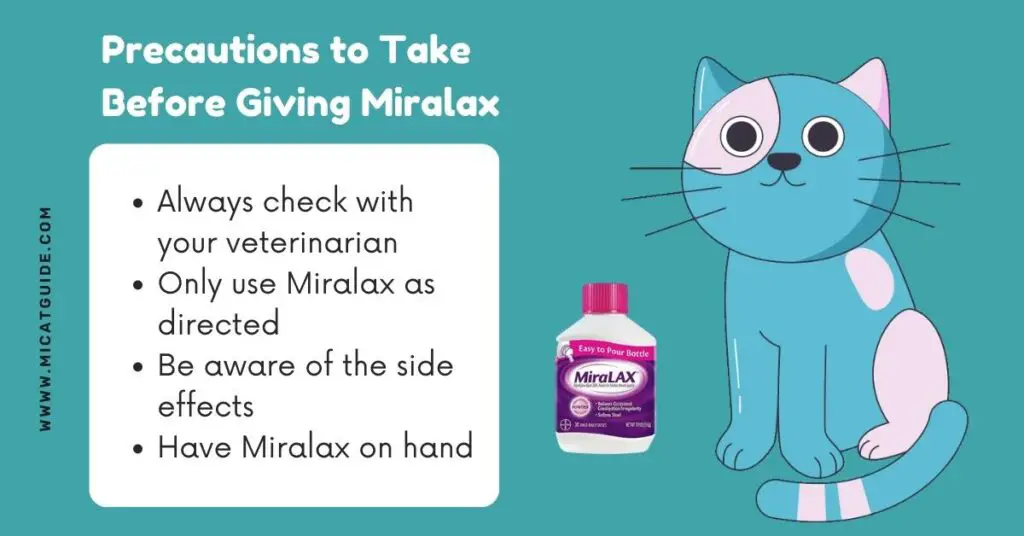
1. Always check with your veterinarian
Yes, Miralax is available over-the-counter, but that doesn’t mean you shouldn’t check with your vet before giving it to your cat. They will help you determine whether Miralax is the best treatment for your cat’s constipation and advise you on the correct dosage.
2. Only use Miralax as directed
Miralax is safe when used as directed, but it can be dangerous if used in excess. Only give your cat the recommended dose and never give them more than the maximum daily dose of 3/4 teaspoon.
3. Be aware of the side effects
Miralax is generally well tolerated, but there are a few potential side effects to be aware of, including diarrhea, vomiting, and stomach pain. If you notice any of these side effects, stop giving Miralax and call your veterinarian.
4. Have Miralax on hand
Cats can become constipated quickly, so it’s important to have Miralax on hand in case your cat needs it. Your veterinarian can prescribe Miralax or you can purchase it over-the-counter at most pharmacies.
What are the Side Effects of Miralax?

Miralax is generally well tolerated, but there are a few potential side effects to be aware of, including diarrhea, vomiting, and stomach pain. Here I’ll go over each of these side effects in more detail.
1. Diarrhea
Diarrhea is the most common side effect of Miralax and is usually only temporary. If your cat has diarrhea after taking Miralax, stop giving them the medication and call your veterinarian. They may recommend you give your cat a smaller dose or switch to a different constipation medication.
2. Vomiting
I know, no one wants to think about their cat vomiting. But it is a potential side effect of Miralax, so it’s important to be aware of it. Vomiting usually only occurs if your cat takes too much Miralax or if they have an underlying condition that makes them more susceptible to vomiting.
3. Stomach pain
Another potential side effect of Miralax is stomach pain. According to the manufacturer, Miralax should not be given to cats with abdominal pain. If your cat takes Miralax and begins showing signs of stomach pain (e.g., crying when touched), stop giving them the medication and call your veterinarian.
How Long Does it Take for Miralax to Work?
The time it takes for Miralax to work varies from cat to cat, but it typically takes 12-24 hours. If you don’t see any improvement within 24 hours, call your veterinarian. They may recommend increasing the dose or switching to a different constipation medication.
A study in the Journal of Veterinary Internal Medicine found that 66% of cats treated with Miralax had a bowel movement within 12 hours. And 95% of cats had a bowel movement within 24 hours.
How Long Can I Give My Cat Miralax?
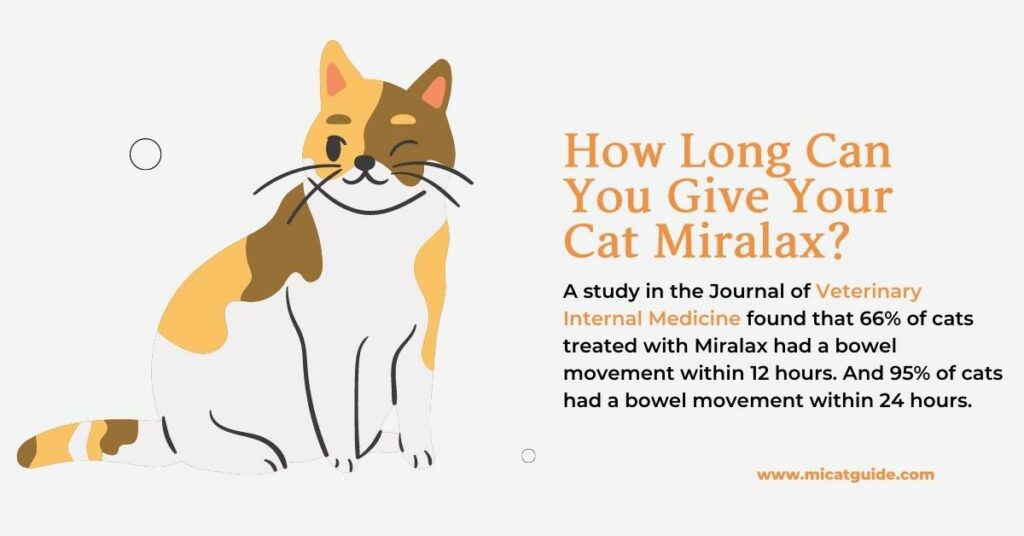
The answer to this question depends on why your cat needs Miralax in the first place. If constipation is due to an underlying medical condition, such as kidney disease, your veterinarian will likely recommend giving Miralax for the rest of your cat’s life.
Diet changes, increased water intake, and/or exercise may also be recommended. If Miralax is being used to help your cat pass a foreign body (e.g., a swallowed toy), it will be stopped once the object has been successfully eliminated.
Some cats need Miralax long-term because of habitual or idiopathic constipation; for these cats, the dose may be slowly decreased over time or given on an as-needed basis. Ultimately, how long you give your cat Miralax will be decided by you and your veterinarian.
Can Miralax be Given with Other Medications?
Miralax can be given with other medications, but there are a few exceptions. Miralax should not be given with certain laxatives (e.g., mineral oil), antacids (e.g., aluminum hydroxide), or stool softeners (e.g., docusate sodium).
Additionally, Miralax should not be given to cats with gastrointestinal obstruction or perforation. If you’re not sure if it’s safe to give Miralax with your cat’s other medications, talk to your veterinarian.
How to Prevent Constipation in Cats?
I hope that this article has helped you understand Miralax and how it can help your constipated cat. But of course, its always better to prevent constipation in the first place. Here are a few tips to help you do just that:
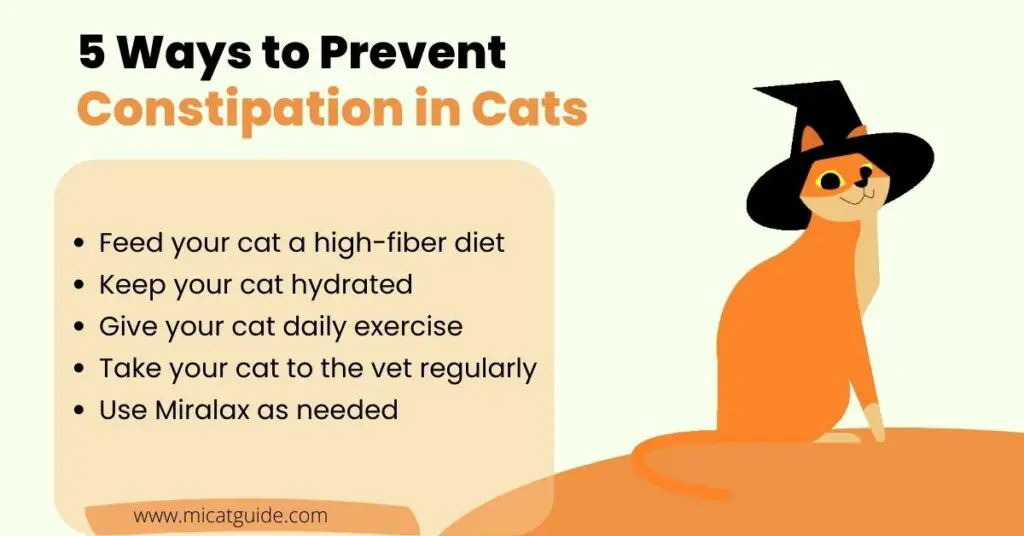
1. Feed your cat a high-fiber diet
As a cat lover, you know that cats are obligate carnivores, which means they require animal-based protein to survive. However, fiber is an important part of a healthy diet for both humans and cats.
While too much fiber can cause gastrointestinal issues (e.g., diarrhea), the right amount of fiber can help keep your cat’s digestive system running smoothly. A high-fiber diet is especially important for cats with chronic constipation.
2. Keep your cat hydrated
Did you know that most cats are chronically dehydrated? It’s true! According to the National Research Council, the ideal water intake for cats is 60-70 ml/kg/day. For a 10 lb (4.5 kg) cat, that’s approximately 3 cups (710 ml) of water per day.
Most cats don’t drink enough water on their own, so its important to encourage them to drink more. One way to do this is by feeding them wet food or adding water to their dry food. You can also try a cat water fountain.
3. Give your cat daily exercise
Cats are naturally lazy creatures, but that doesn’t mean they don’t need exercise. In fact, lack of exercise is one of the most common causes of constipation in cats. Just like humans, cats need to move their bodies to keep their digestive system running smoothly.
There are lots of ways to help your cat get exercise, such as playing with them for 10-15 minutes each day, setting up a climbing tower or cat tree, or investing in an automatic laser toy. Just find what works for your cat and stick with it!
4. Take your cat to the vet regularly
Regular vet check-ups are important for all cats, but they’re especially important for cats with constipation. That’s because constipation can be a sign of an underlying medical condition, such as dehydration, kidney disease, or intestinal blockage.
If you think your cat may be constipated, don’t wait to take them to the vet. The sooner you identify the problem, the sooner you can get your cat the treatment they need.
5. Use Miralax as needed
Of course, even if you do everything right, your cat may still suffer from occasional constipation. And that’s where Miralax comes in! Miralax is a safe and effective way to relieve constipation in cats. Just be sure to talk to your vet before using it.
The Bottom Line
Constipation is a common problem in cats, but it’s usually nothing to worry about. In most cases, constipation can be relieved with simple lifestyle changes, such as increasing fiber and water intake and getting more exercise.
If lifestyle changes don’t work, Miralax is a safe and effective way to relieve constipation in cats. While it is always important to consult with a veterinarian before administering medication to a pet, this article provides general guidelines for how much Miralax to give a 17 pound cat.
If your cat weighs more or less than 17 pounds, be sure to adjust the dosage accordingly. As always, if you have any concerns about your pet’s health, please contact your veterinarian
I hope this article has helped you understand everything you need to know about Miralax for cats. If you have any questions or concerns, please talk to your veterinarian. Thanks for reading!

